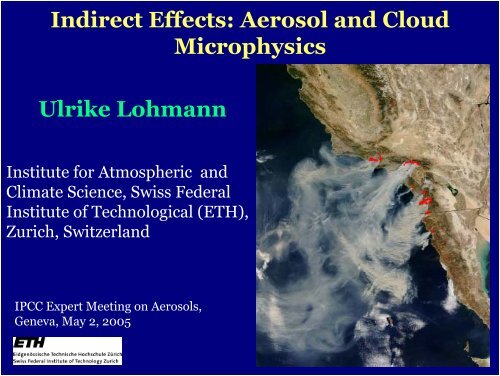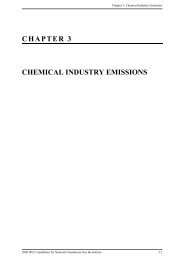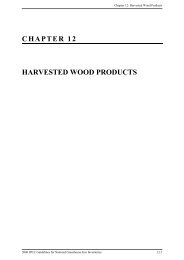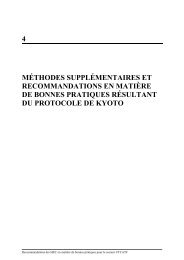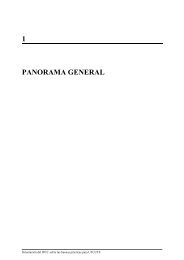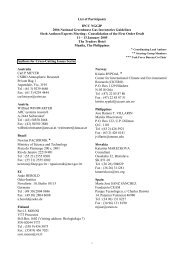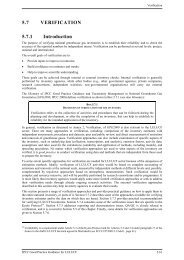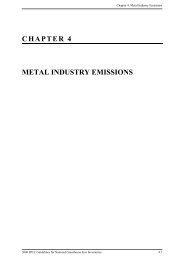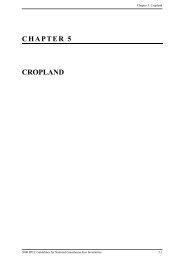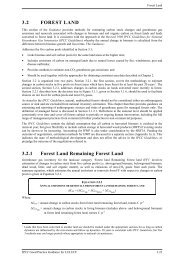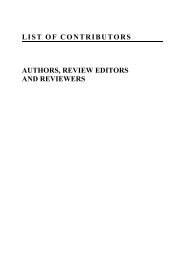Indirect Effects: Aerosol and Cloud Microphysics Ulrike Lohmann
Indirect Effects: Aerosol and Cloud Microphysics Ulrike Lohmann
Indirect Effects: Aerosol and Cloud Microphysics Ulrike Lohmann
Create successful ePaper yourself
Turn your PDF publications into a flip-book with our unique Google optimized e-Paper software.
<strong>Indirect</strong> <strong>Effects</strong>: <strong>Aerosol</strong> <strong>and</strong> <strong>Cloud</strong><br />
<strong>Microphysics</strong><br />
<strong>Ulrike</strong> <strong>Lohmann</strong><br />
Institute for Atmospheric <strong>and</strong><br />
Climate Science, Swiss Federal<br />
Institute of Technological (ETH),<br />
Zurich, Switzerl<strong>and</strong><br />
IPCC Expert Meeting on <strong>Aerosol</strong>s,<br />
Geneva, May 2, 2005
Outline<br />
• What are aerosol indirect effects?<br />
– Twomey effect<br />
– <strong>Cloud</strong> lifetime effect<br />
– Semi-direct effect<br />
• Evidence of the different indirect aerosol effects<br />
from field studies<br />
• Estimates of global mean indirect aerosol effects<br />
• Conclusions
Water<br />
clouds<br />
<strong>Cloud</strong> condensation<br />
nuclei (CCN)<br />
Oxidation,<br />
Nucleation<br />
<strong>Aerosol</strong> removal<br />
by precipitation<br />
SO 2 , NO x ,<br />
Organics<br />
Soot,<br />
organics<br />
Soil dust<br />
saltation<br />
Sea salt<br />
Industry<br />
Automobiles<br />
Biomass burning<br />
Arid area<br />
Ocean spray
<strong>Indirect</strong><br />
aerosol<br />
effects on<br />
climate<br />
Penner et al., IPCC, 2001
Different aerosol effects on water clouds<br />
• <strong>Cloud</strong> albedo effect (pure forcing)<br />
– for a constant cloud water content, more aerosols lead to<br />
more <strong>and</strong> smaller cloud droplets larger cross sectional<br />
area more reflection of solar radiation<br />
• <strong>Cloud</strong> lifetime effect (involves feedbacks)<br />
– the more <strong>and</strong> smaller cloud droplets will not collide as<br />
efficiently decrease drizzle formation increase cloud<br />
lifetime more reflection of solar radiation<br />
• Semi-direct effect (involves feedbacks)<br />
– absorption of solar radiation by black carbon within a cloud<br />
increases the temperature decreases relative humidity <br />
evaporation of cloud droplets more absorption of solar<br />
radiation (opposite sign)
<strong>Cloud</strong> evolution in a clean <strong>and</strong> polluted atmosphere<br />
Kaufman<br />
et al.<br />
2002
Shiptracks<br />
off the coast<br />
of<br />
Washington<br />
Durkee et al., 2000
Evidence for the cloud albedo effect<br />
Durkee et al.,<br />
JAS, 2000
Top-of-the-atmosphere global-mean radiative<br />
forcing (W m -2 ) for 2000 relative to 1750 [IPCC, 2001]
Estimate of the total radiative (aerosol <strong>and</strong> nonaerosol)<br />
forcing since pre-industrial times<br />
Boucher <strong>and</strong><br />
Haywood, Clim.<br />
Dyn., 2001
Summary of aerosol forcing estimates<br />
[Anderson et al., Science, 2003]
Example of an inverse simulation [Knutti et al., 2002]<br />
Probability density functions<br />
of the global mean indirect<br />
effect:<br />
d) not constrained<br />
e) contrained by observed T<br />
record<br />
f) also constrained by the IPCC<br />
climate sensitivity<br />
Simulated relation between<br />
climate sensitivity (∆T/<br />
2xCO 2 ) <strong>and</strong> atmospheric<br />
<strong>and</strong> oceanic warming:<br />
a) global ocean heat uptake<br />
from 1955-1995 in the upper<br />
3 km<br />
b) atmospheric temperature<br />
from 1900-2000
How are aerosol effects on clouds simulated in<br />
climate models?<br />
• Predict aerosol mass concentrations:<br />
– sources (aerosol emissions of the major aerosol species:<br />
sulfate, black carbon, organic carbon, sea salt, dust)<br />
– transformation (dry <strong>and</strong> wet deposition, chemical<br />
transformation <strong>and</strong> transport)<br />
• Need a good description of cloud properties:<br />
– precipitation formation (collision/coalescence of cloud<br />
droplets <strong>and</strong> ice crystals, riming of snow flakes)<br />
• Need to parameterize aerosol-cloud interactions:<br />
– cloud droplet nucleation (activation of hygroscopic aerosol<br />
particles)<br />
– ice crystal formation (contact <strong>and</strong> immersion freezing,<br />
homogeneous freezing in cirrus clouds)
Global annual mean aerosol emissions<br />
(representative for 1985)<br />
100<br />
90<br />
80<br />
70<br />
60<br />
50<br />
40<br />
30<br />
20<br />
10<br />
0<br />
318<br />
Sulfur Soot OC Dust<br />
< 1 mu<br />
Sea-salt<br />
< 1 mu<br />
Tg S/C per year<br />
Natural<br />
Anthropogenic<br />
Anthropogenic<br />
Emissions<br />
from<br />
Biomass burning<br />
<strong>and</strong><br />
Fossil fuel use
<strong>Aerosol</strong> mass resulting from human activity
<strong>Cloud</strong> microphysical processes in a climate model<br />
Evaporation<br />
<strong>Aerosol</strong>s<br />
Sulfate, sea salt, organics, dust, soot<br />
Sublimation<br />
Nucleation<br />
q l N d<br />
Evaporation<br />
Condensation<br />
Vapor<br />
Homo/Hetero. Freezing<br />
Melting<br />
Sublimation<br />
Deposition<br />
Nucleation<br />
q i N i<br />
Selfcollection<br />
Autoconversion<br />
Accretion<br />
Riming<br />
Depositional Growth<br />
Aggregation<br />
Accretion<br />
Freezing<br />
Rainfall<br />
Melting<br />
Snowfall
<strong>Aerosol</strong> - cloud droplet relationships<br />
Penner et<br />
al., IPCC,<br />
2001
Temporal<br />
evolution of<br />
sulphur<br />
emission<br />
<strong>and</strong> direct<br />
<strong>and</strong> indirect<br />
radiative<br />
forcing of<br />
sulfate<br />
aerosols<br />
Boucher <strong>and</strong><br />
Pham, GRL, 2002
Top panel:<br />
Direct effect<br />
of sulphate<br />
aerosols (–0.4<br />
W/m 2 )<br />
Lower panel:<br />
<strong>Indirect</strong> cloud<br />
albedo effect<br />
(–1.o W/m 2 )<br />
Boucher <strong>and</strong><br />
Pham, GRL, 2002
<strong>Cloud</strong> lifetime effect calculations<br />
The autoconversion rate (precipitation formation rate in clouds<br />
with no ice) in climate models depends on the cloud water<br />
content q l <strong>and</strong> the number concentration of cloud droplets N:<br />
Q aut ~ q la N b<br />
with a=2-5<br />
b=-1 to -3.3<br />
more cloud<br />
droplets decrease<br />
drizzle formation
<strong>Aerosol</strong> effects<br />
on cloud water<br />
content<br />
between preindustrial<br />
<strong>and</strong><br />
present-day<br />
times
<strong>Indirect</strong> aerosol effect<br />
Difference between two 5-year simulations one with pre-industrial <strong>and</strong> one with<br />
present-day aerosol emissions<br />
[Global mean change in top-of-the-atmosphere net radiation: -1.4 W/m 2 ]<br />
Peng <strong>and</strong> <strong>Lohmann</strong>, GRL, 2003
Semi-direct<br />
effect<br />
Ackerman et al., Science, 2000
Semi-direct<br />
effect<br />
DIRECT<br />
Change in liquid water<br />
path with black carbon<br />
for the experiments<br />
DIRECT, INDIRECT <strong>and</strong><br />
ALL<br />
INDIRECT<br />
<strong>Lohmann</strong> <strong>and</strong> Feichter,<br />
GRL, 2001<br />
ALL
Global mean indirect aerosol effect (Twomey vs.<br />
lifetime) from different climate models<br />
Sulfate<br />
Soot (BC) <strong>and</strong><br />
sulfate<br />
Organic aerosols<br />
(OC) <strong>and</strong> sulfate<br />
BC, OC <strong>and</strong> sulfate<br />
<strong>Lohmann</strong> <strong>and</strong><br />
Feichter, ACP,<br />
2005
Summary<br />
• <strong>Aerosol</strong> effects on the radiative balance are<br />
significant. At the top-of-the atmosphere, the<br />
cooling effect from sulfate <strong>and</strong> organic aerosols is<br />
partly offset by the warming by black carbon.<br />
• All aerosols cause a reduction of solar radiation at<br />
the Earth surface.<br />
• In addition aerosols significantly influence air<br />
quality <strong>and</strong> the hydrological cycle.<br />
• We will know more about each individual aerosol<br />
species, including their effects on ice clouds, by the<br />
time the Forth IPCC Assessment report is published.


